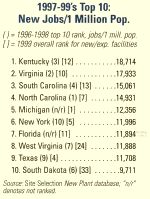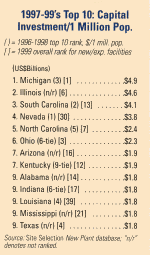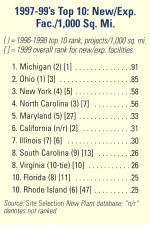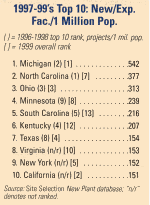Albert Einstein, Time‘s “Man of the Century,” knew a thing or two about proportional perspectives.
“When you are courting a nice girl,” he observed, “an hour seems like a second. When you sit on a red-hot cinder, a second seems like an hour. That’s relativity.”

So it is. And there’s also a strong shot of relativity in state business expansion totals. It’s simply a bit silly to do midgets-to-monoliths comparisons between, say, Texas, with 20 million residents in 266,807 sq. miles (691,027 sq. km.), with Rhode Island, with 990,000 residents in 44 sq. miles (114 sq. km.).

That’s why Site Selection annually levels the state playing field for population and landmass. Using three-year rolling tallies, those analyses often yield a markedly different business attraction hierarchy.
Shakeups were plentiful in this year’s proportional top 10s, even with 1999 Governor’s Cup winner Michigan taking three of four No. 1s:
• Capital investment per 1 million residents: Riding the cumulative wave of three straight Governor’s Cup wins, Michigan ranks No. 1. New faces, though, populate much of the rest of this top 10, with eight the 13 ranked states (due to ties) unranked in 1999’s overall top 10. No. 13 in 1999’s overall totals, South Carolina catapults to No. 2 here. Also breaking into this top 10 were Nevada (last year’s No. 1) at No. 4; Arizona and Kentucky, tied for No. 7; and Alabama, Indiana, Louisiana and Mississippi, all in a five-way tie with Texas for No. 9.
• New jobs per 1 million residents: 1999’s overall No. 13, Kentucky leapfrogged to No. 1 in this analysis, which tends to reward deals with hefty job projections. Four other states unranked in 1999’s top 10 make this honor roll: No. 3 South Carolina, No. 7 Florida, No. 8 West Virginia and No. 10 South Dakota.
• New and expanded facilities per 1,000 sq. miles (2,600 sq. km.): 1999’s overall No. 27, Maryland skyrockets to No. 5 here, with No. 9 South Carolina and No. 10 Florida also breaking in.

• New and expanded facilities per 1 million residents: Though it registered the smallest shakeup, this analysis still ranked South Carolina No. 4 and Kentucky No. 5.
1999’s proportional analyses also uncovered a considerable raising of the competitive bar, owing to the extended U.S. economic surge. For projects per 1 million residents, for example, No. 1 Michigan’s total marks a striking 38 percent increase from Ohio’s No. 1 total last year.

SS’s other proportional analyses saw similar upsurges in the required ranking ante. The No. 1 tally was 20 percent higher than last year for capital investment per 1 million residents, 17 percent higher for projects per 1,000 sq. miles, and 16 percent higher for new jobs per 1 million residents.
Given those conspicuously higher tallies, not even proportional analyses seem to offer any respite from the crackling competition for corporate facilities. Or, as Einstein might’ve said, for some states the girls keep getting nicer, while for others, the cinders grow hotter. — Jack Lyne